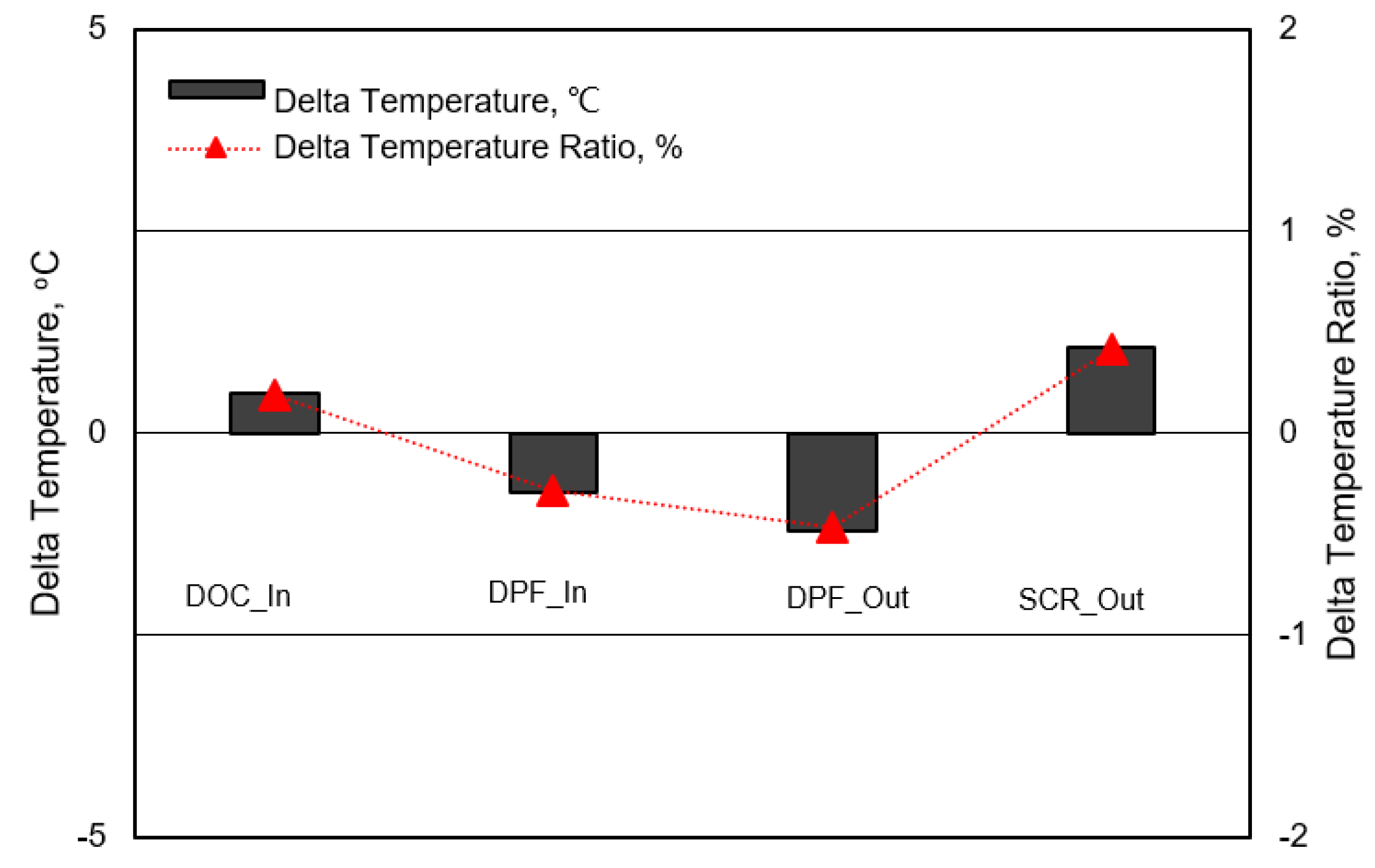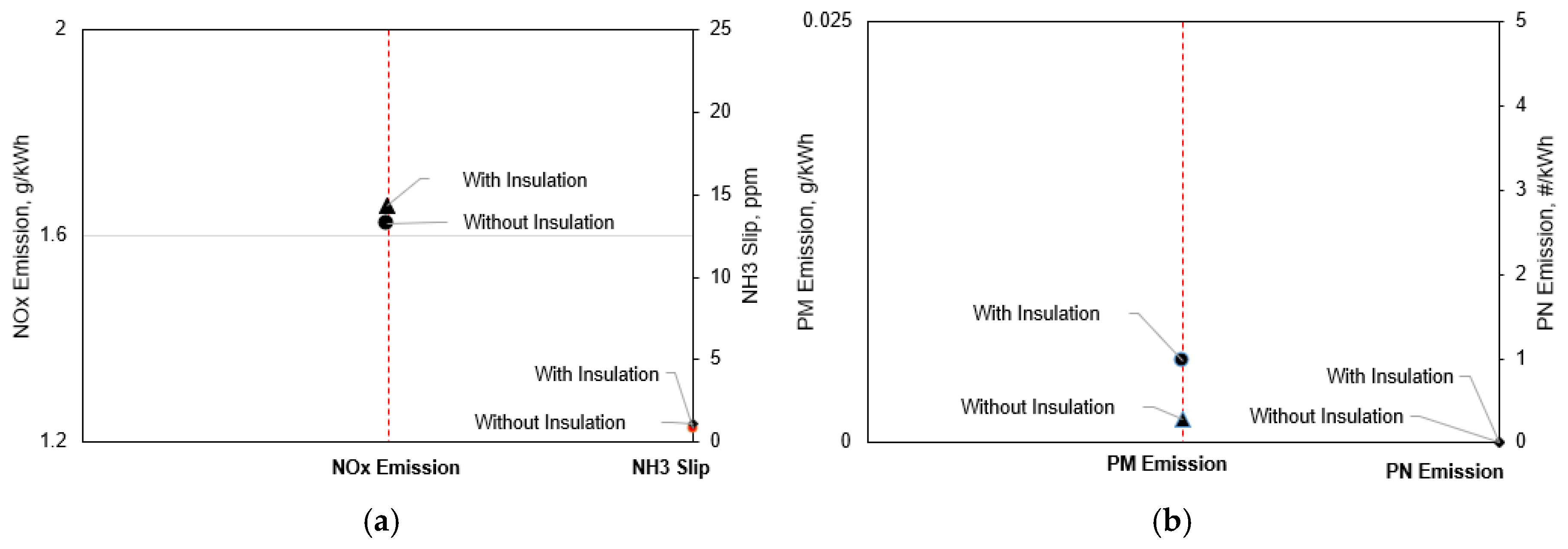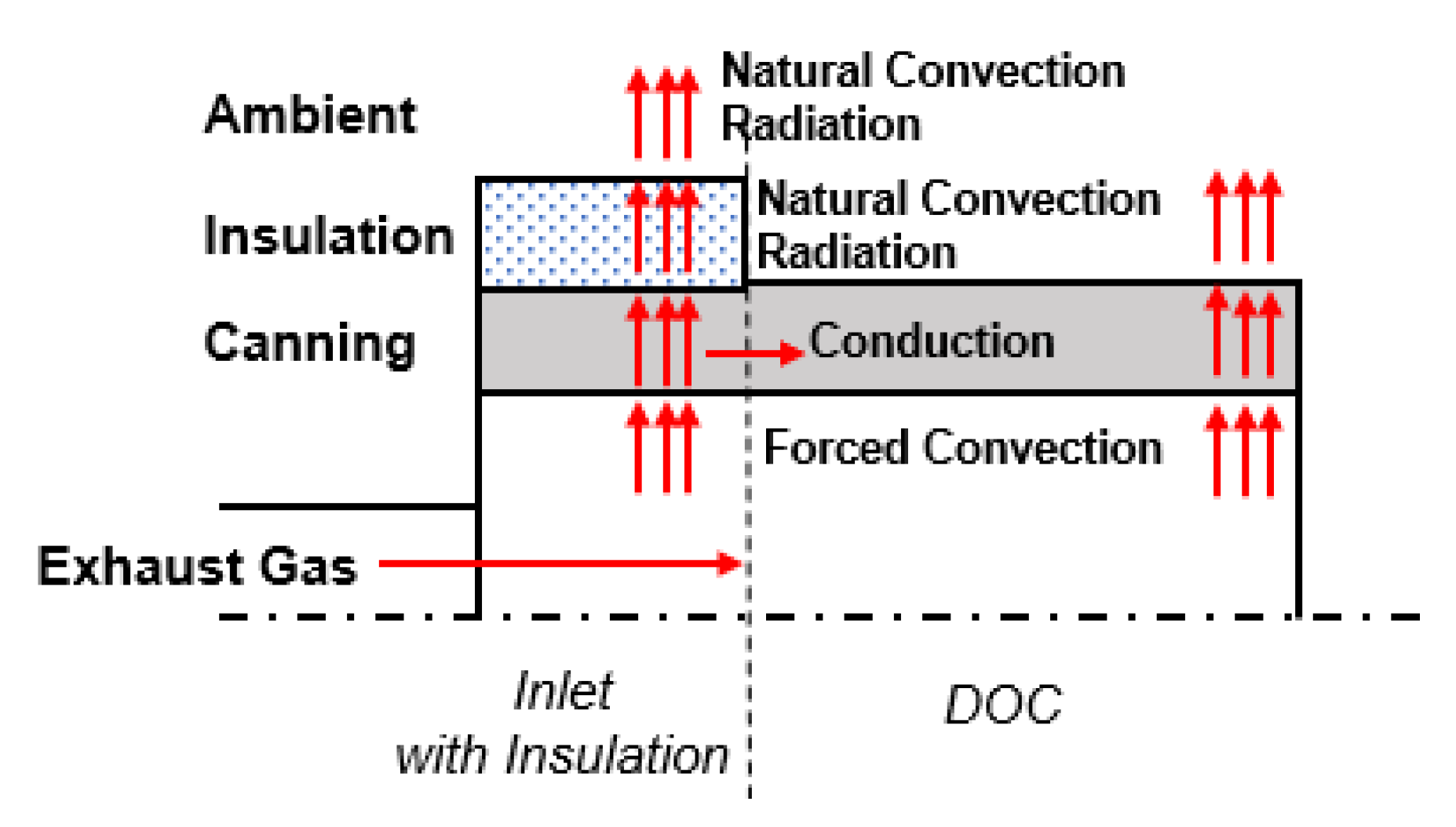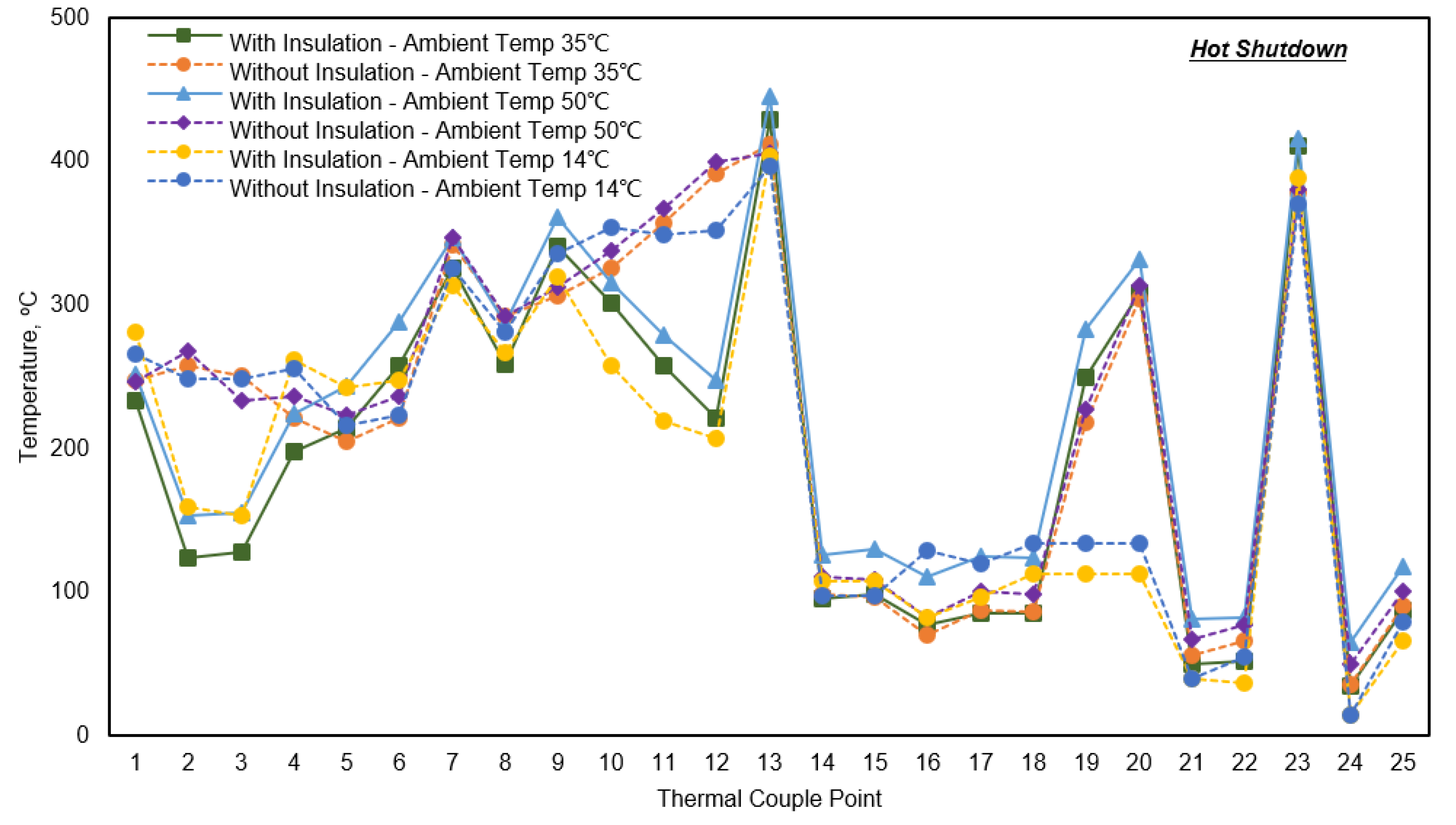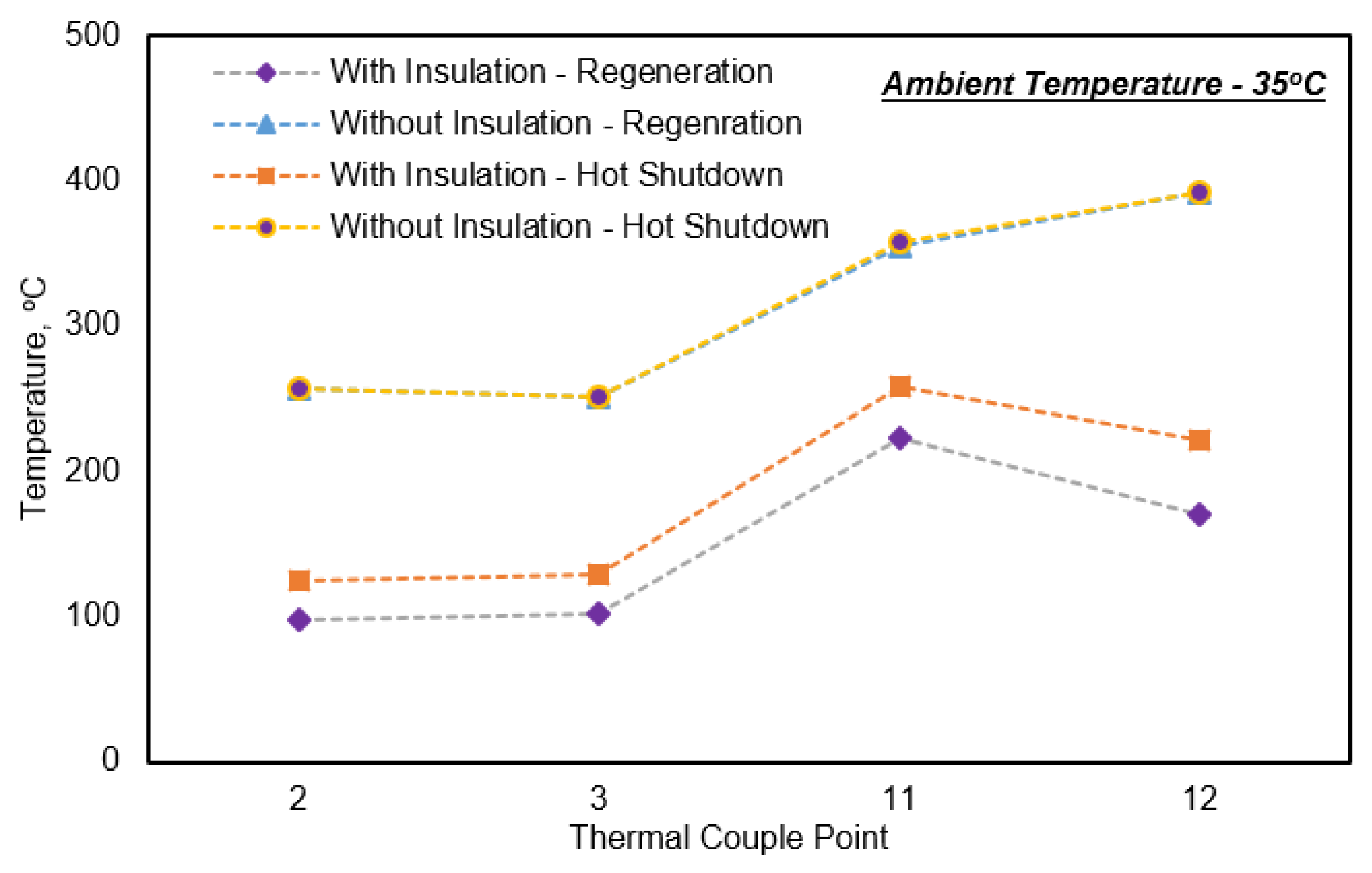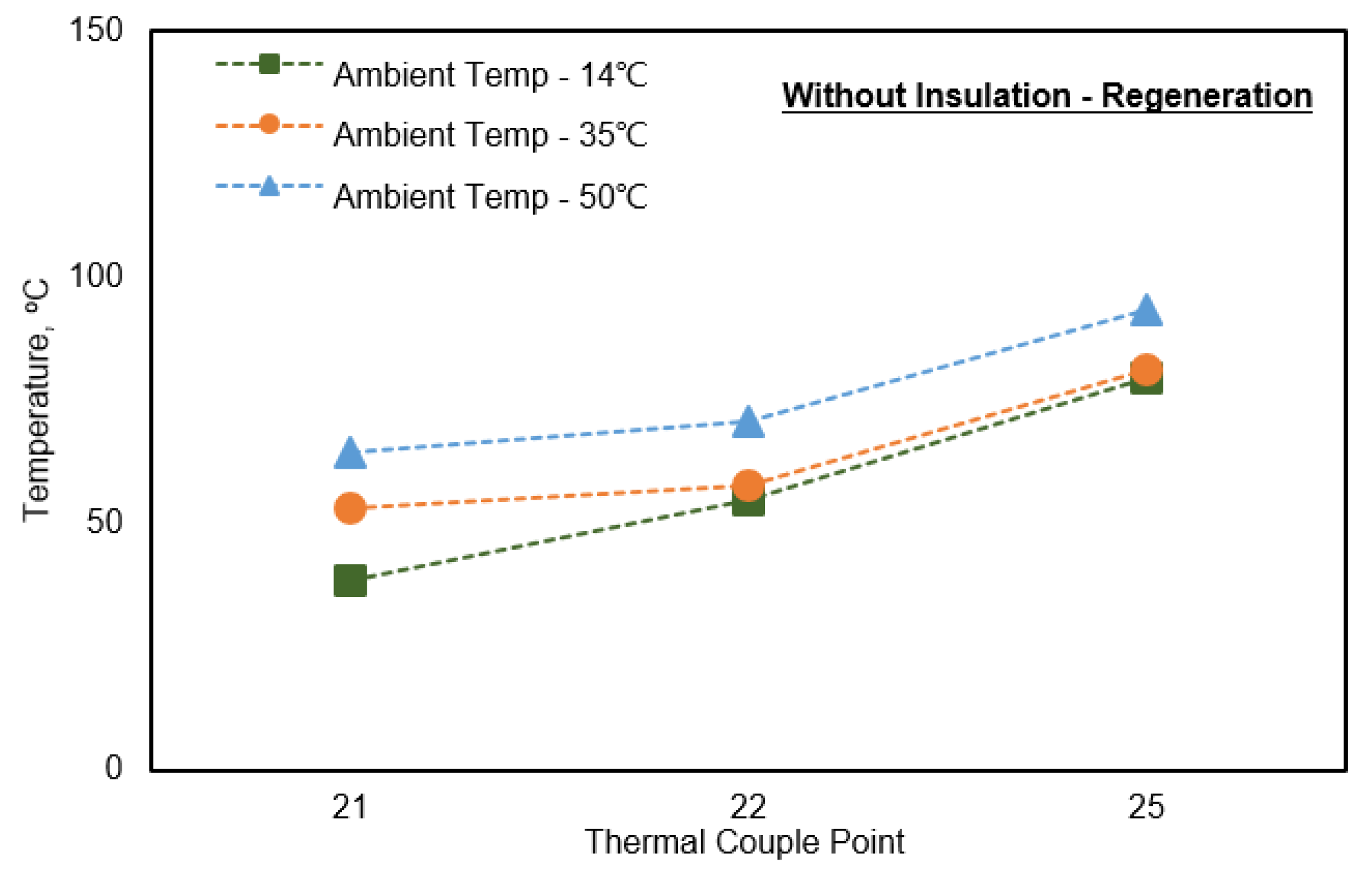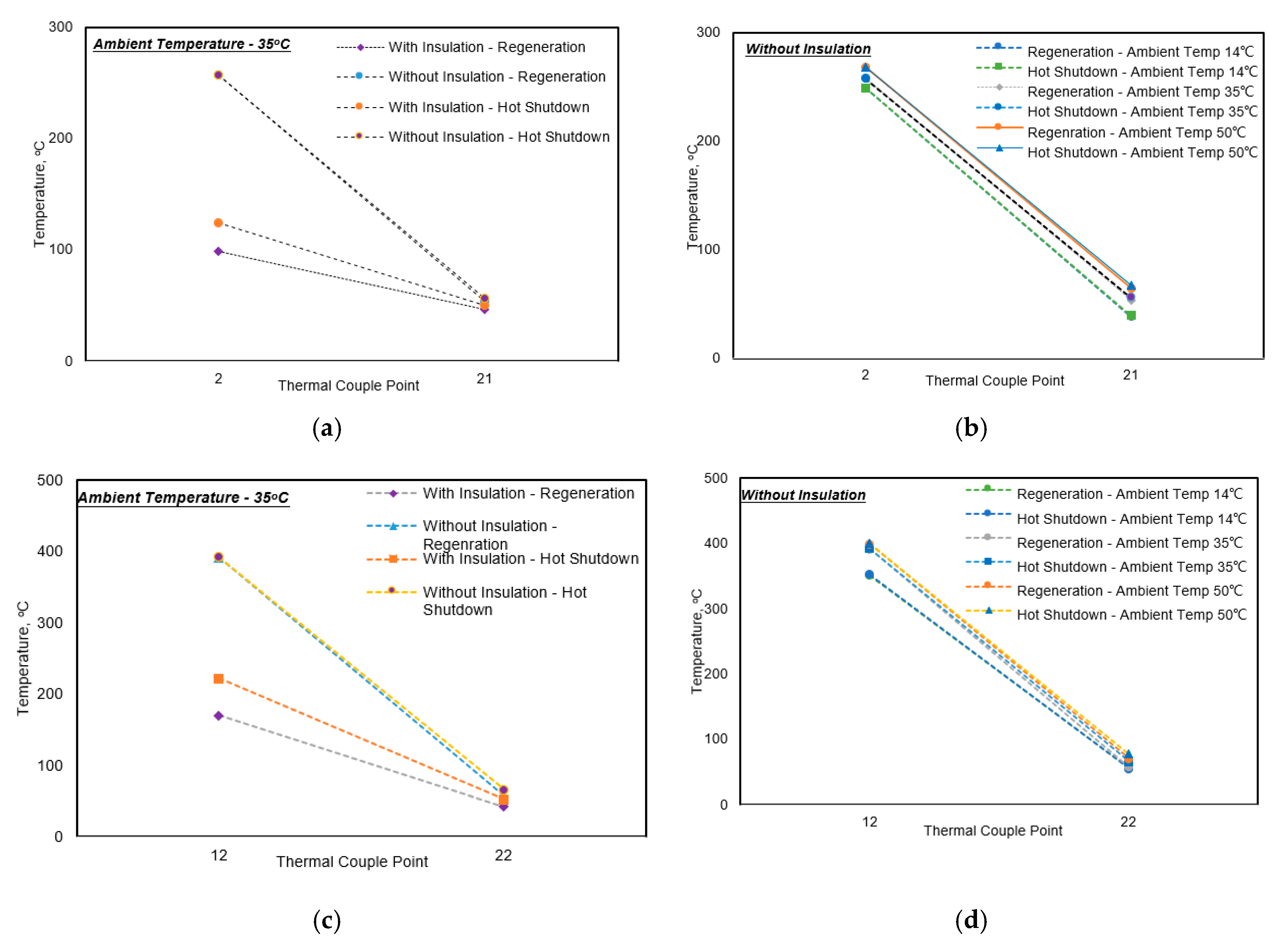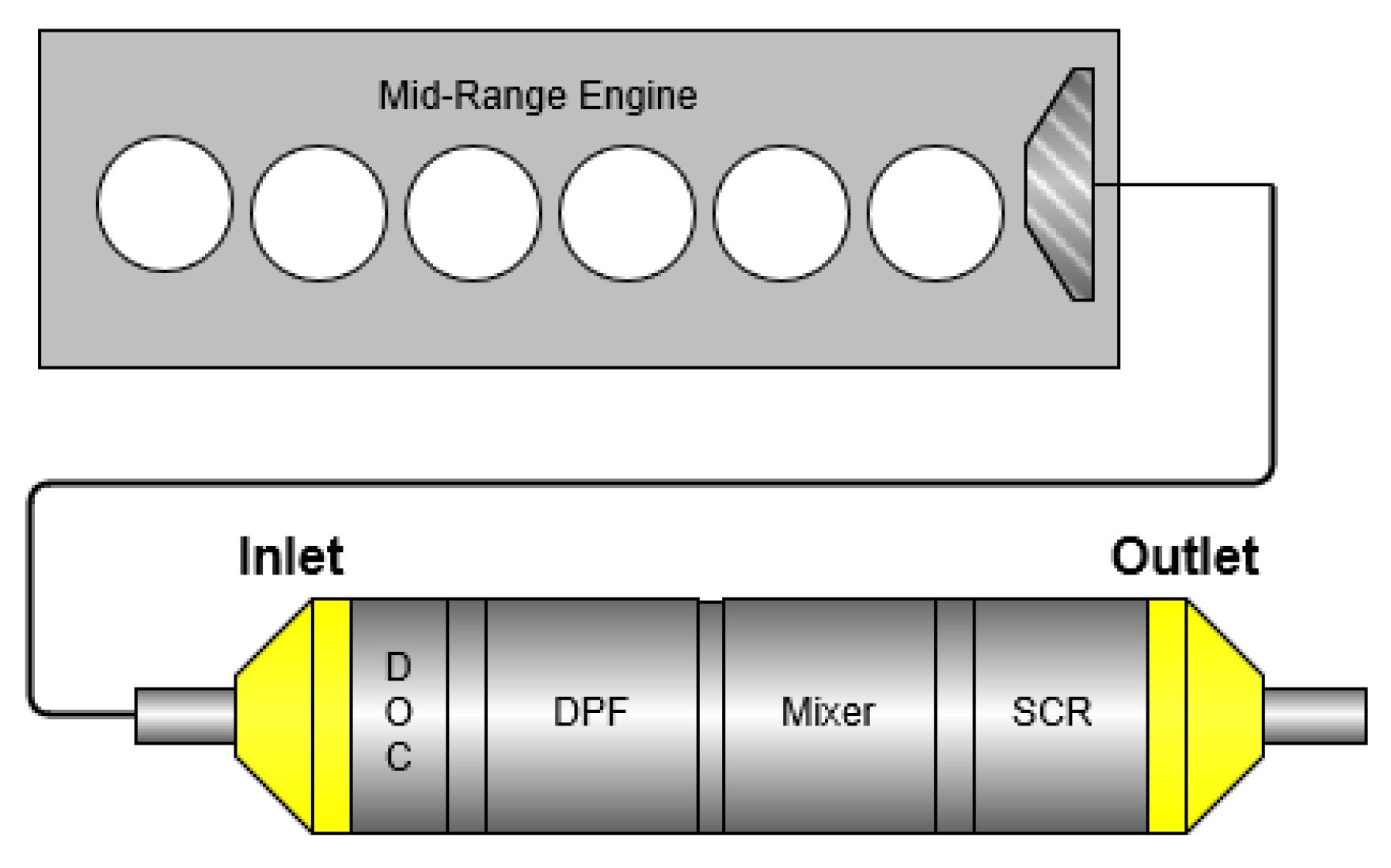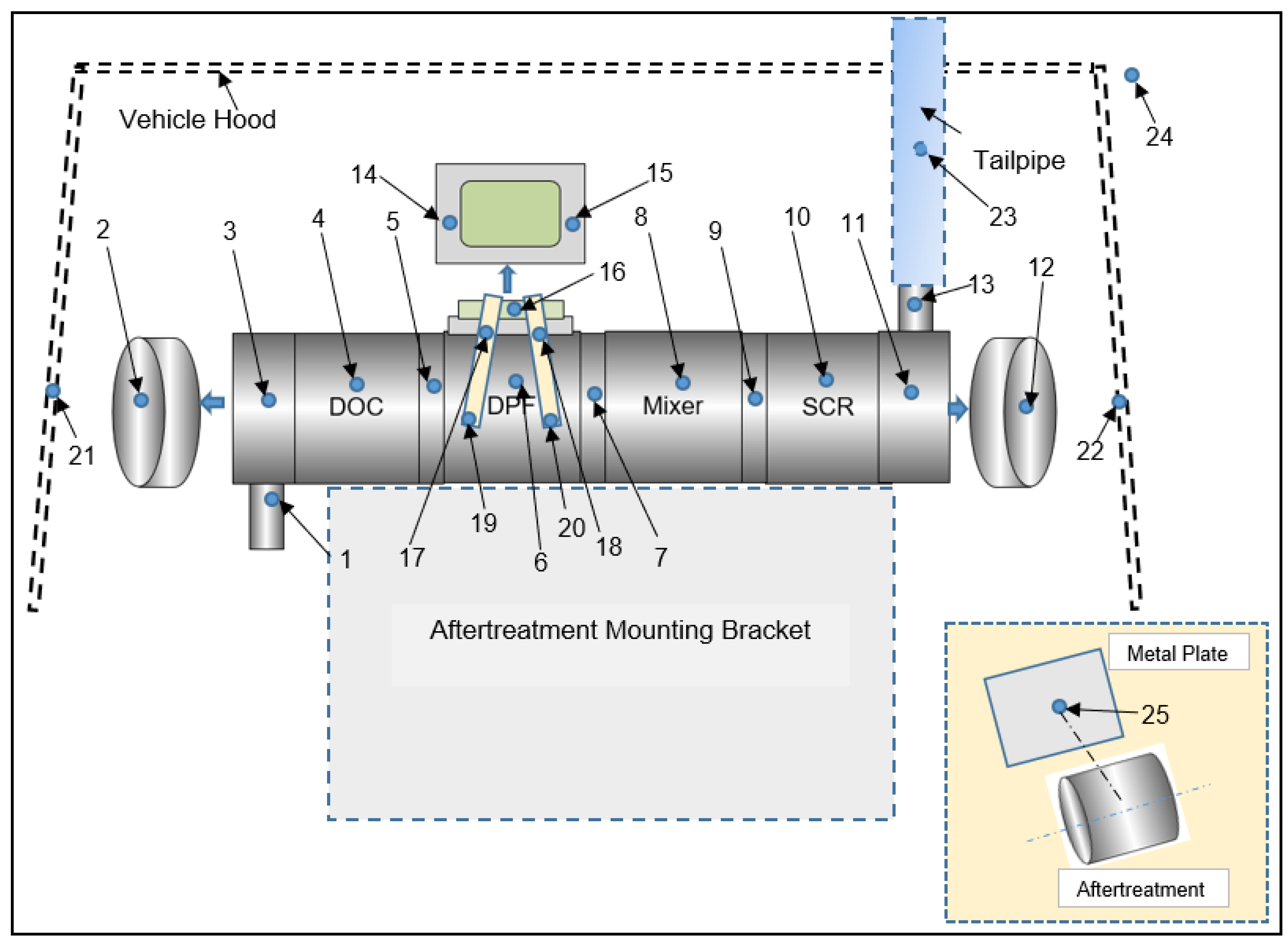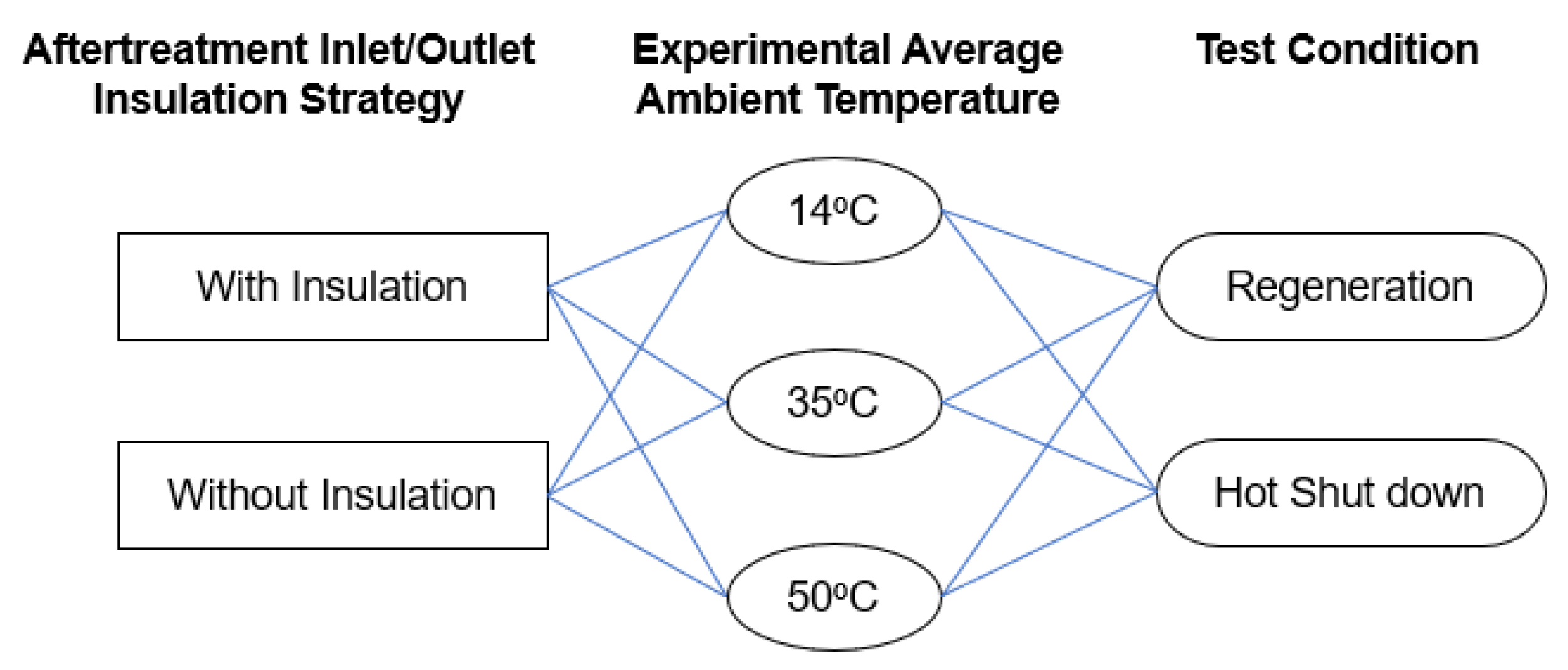2.2.1. Theoretic Considerations
When introducing the aftertreatment into real applications, the aftertreatment skin temperature and radiated impact need to be taken into consideration. On the one hand, this helps to understand aftertreatment skin temperature mapping to provide guidance for safety, as well as taking into account the additional parts on the surface of aftertreatment with material having special temperature limit requirements. On the other hand, the radiated impact of aftertreatment on neighboring parts of the vehicle may need to be referenced when comprehensively designing the arrangement of vehicle parts. Although the aftertreatment inlet/outlet insulation strategies could both meet emission requirements, the aftertreatment skin temperature needs further research with and without insulation due to heat transfer.
NOx conversion and DPF regeneration are the significant processes when taking the two different aftertreatment inlet/outlet insulation strategies into considerations. These processes result in several conversions inside the aftertreatment by catalysts with heat influences.
Urea dosing into the mixer through a urea injector may be necessary according to a control strategy to achieve a specific NOx conversion efficiency in certain conditions to meet strict regulation requirements.
Figure 3 [
19] illustrates a urea pyrolysis mechanism and schematic for droplet evaporation, which explains the complex reactions during heat transfer stages within the aftertreatment. The urea droplets begin to evaporate when the temperature rises due to being gradually heated by exhaust gas. The water starts to evaporate from the aqueous urea solution at the earliest point in time due to it having a lower boiling point. Urea can be directly pyrolyzed from the solid or liquid phase, so the second stage in
Figure 3 is negligible.
In a word, the urea droplets are heated up and water evaporates first, followed by the thermolysis of urea into ammonia and isocyanic acid [
20].
The main reaction of NOx conversion is as below.
DPF regeneration generally includes passive regeneration and active regeneration. Passive regeneration typically depends on the engine conditions and availability of NOx, which is the soot oxidization in the course of normal conditions as a result of the reaction of carbon with NO
2, which is from the NO oxidation in DOC.
Active regeneration actively increases the temperature to accelerate soot oxidization by O
2, achieved by engine fuel post injection to inject additional fuel and burning over DOC to achieve the regeneration temperature, which is higher than 500 °C. The thermal management in the whole system control strategy ensures this can be smartly realized.
The aftertreatment inlet is designed before the DOC module, while the outlet is after SCR. Considering multiple complex reactions occur in catalysts satisfying requirements under different conditions, the heat transfer onto the aftertreatment surface would be different.
Figure 4 shows an aftertreatment inlet heat transfer model taking an inlet with insulation as an example. Heat transfer phenomena are considered in the figure including convection, conduction and radiation. According to heat energy balance, the aftertreatment skin temperature could be introduced as formula (9).
where
represents aftertreatment skin temperature;
and
stand for exhaust gas mass internal energy, enthalpy and temperature;
is heat transfer coefficient between the contents of different phases;
is catalyst temperature;
is heat of catalyst reaction.
The aftertreatment skin temperature at different points would be investigated corresponding to several kinds of experimental conditions that are carried out in this experimental part.
2.2.2. Overall Results under Different Test Conditions
Figure 5 shows a scatter diagram for all measured maximum temperatures on each test thermal mapping point under all experimental conditions with three ambient temperature environments using the two aftertreatment inlet/outlet insulation designs. From the diagram it can be seen that
1) The higher maximum temperatures concentrate on points 12, 13 and 23, which are higher than 400 °C. Point 23 is the aftertreatment outlet tube internal gas temperature. The exhaust gas comes from the engine turbo charger and flows through the catalysts for several reactions which target control strategies to meet emission requirements, which results in the exhaust gas being in a high state whichever aftertreatment inlet/outlet strategy is used. Point 12 represents the maximum skin temperature of the outlet module. From the temperature shown on point 12 under different experimental conditions, the maximum skin temperature of the outlet module is quite different depending on the experimental conditions and which is estimated according to the outlet insulation design. At point 13 it can be observed that the max skin temperature of the aftertreatment outlet tube is around 400 °C, considering different experimental conditions, which validates that the inlet/outlet insulation design has little impact on the maximum temperature of the aftertreatment outlet tube if the tube design remains the same.
2) Points 2, 3, 11 and 12 show the maximum skin temperature is distributed as a large range under different experimental conditions. These four points stand for the temperatures on the surfaces of the aftertreatment inlet and outlet modules, which means that it can be estimated that the aftertreatment inlet/outlet insulation design affects their skin temperature and needs further analysis under the experimental conditions.
3) The lower maximum temperature concentrates on points 21, 22 and 25, which all represent the surface temperature of the neighboring parts of the aftertreatment. It can be imaged that there is heat loss from the surface of the aftertreatment to its neighboring parts on the vehicle and that this results in a lower surface temperature on these parts than on the aftertreatment.
4) Points 14, 15, 16, 17 and 18 show that the maximum temperature for the DPF related skin temperature is similar for each point under different experimental conditions. This is mainly due to the fact that the DPF design is the same.
Figure 6 shows the max temperature at each thermal couple point under regeneration, and
Figure 7 shows the max temperature at each thermal couple point under hot shut down.
Figure 6 shows that
1) When DPF is in active generation, the internal gas temperature will be higher than 500 °C. With the design of the DPF packaging being consistent, the DPF related maximum skin temperature at points 14, 15, 16, 17 and 18 is similar at each single point under several experimental conditions. Point 17 and point 18 are the maximum skin temperatures of differential pressure sensor tubes with the highest measured data as 124 °C, which also provides guidance when choosing material for the design of differential pressure sensor tubes.
2) From the overall trend shown in this figure, it can be said that all the maximum skin temperatures rise with higher ambient temperature.
3) Per point 4, 6 and 10, it can be observed that under the same ambient temperature, the maximum skin temperature of the DOC module is similar when the aftertreatment inlet/outlet has or does not have insulation, as is the DPF module maximum skin temperature and the SCR maximum module skin temperature. In the emission experiment described above, the gas temperature at DOC_In, DPF_In, DPF_Out and SCR_Out is very similar when considering the aftertreatment inlet/outlet with or without insulation. According to the heat radiation model, the maximum skin temperatures of the catalyst modules are similar for the aftertreatment inlet/outlet with insulation and without insulation, as the packaging of the catalyst modules packaging maintains a consistent design.
4) Under the same experimental condition, point 2 and point 3 show the inlet related skin temperatures are higher for the aftertreatment inlet/outlet without insulation than for that with insulation. Point 11 and point 12 show the inlet related skin temperatures are higher for the aftertreatment inlet/outlet without insulation than for that with insulation. The inlet and outlet skin temperatures are significantly impacted by the insulation design. With insulation, the highest inlet skin temperature (point 3) is about 150 °C, and the highest outlet skin temperature (point 11) is 280 °C, while without insulation, the highest inlet skin temperature (point 3) is about 250 °C, and the highest outlet skin temperature (point 11) is 370 °C.
Figure 7 considers all the maximum skin temperatures measured under hot shut down condition, and the tested data shows the same observations in
Figure 6.
2.2.3. Inlet/Outlet Skin Temperature Test Results and Analysis
To further investigate aftertreatment inlet and outlet skin temperature under different experimental conditions,
Figure 8 shows the maximum skin temperature at aftertreatment inlet and outlet taking an ambient temperature of 35 °C as an example. Point 2 and point 3 represent aftertreatment inlet related maximum skin temperature, while point 11 and point 12 represent aftertreatment outlet related maximum skin temperature.
1) The maximum skin temperatures of point 2 and point 3 are close to each other under the same experimental conditions with the same aftertreatment configuration, and the maximum skin temperatures of the inlet module are lower when the aftertreatment has insulation than those when the aftertreatment does not have insulation. The temperatures are higher under hot shut down condition than under regeneration condition. With insulation, the highest inlet skin temperature (point 3) is about 150 °C, while without insulation, the highest inlet skin temperature (point 3) is about 250 °C.
2) The maximum skin temperatures of point 11 and point 12 are lower for aftertreatment with insulation than those for aftertreatment without insulation. The temperatures are similar under hot shut down condition and under regeneration condition. With insulation, the highest outlet skin temperature (point 11) is about 280 °C, while without insulation, the highest inlet skin temperature (point 11) is about 370 °C.
3) The maximum skin temperature of the aftertreatment for the outlet is higher than that for the inlet for a specific aftertreatment configuration under the same experimental condition.
Generally, this could make the inlet and outlet surface maximum temperatures lower with insulation on the surface. When considering the real application on a vehicle, the aftertreatment radiated heat impact on the neighboring parts in the vehicle needs to be understood. The inlet and outlet surface temperature radiated heat impact on the neighboring parts in the vehicle is further investigated and analyzed for the real vehicle experimental cases with the two aftertreatment inlet/outlet insulation strategies. This considers the distance between the aftertreatment and its neighboring parts in the vehicle to carry out the work for the test results analysis, as well as the theoretic model explanation.
2.2.4. Radiated Impact on Neighboring Parts in the Vehicle
The parts in the vehicle which are close to the aftertreatment may be impacted by aftertreatment skin heat. In this nonroad vehicle arrangement, there are three parts that are around the aftertreatment—the vehicle hood near the aftertreatment inlet end plate, which is at a distance of 62 mm with point 21 to record the maximum surface temperature of the inner vehicle hood, the other side of the vehicle hood near the aftertreatment outlet end plate, which is at a distance of 62 mm with point 22 to record the maximum surface temperature of the inner vehicle hood, and a metal plate, with point 25 to record the temperature and for which the distance between point 5 and point 25 is 95 mm. For the aftertreatment inlet/outlet without insulation, the inlet/outlet end plate maximum skin temperatures are higher than those for the aftertreatment inlet/outlet with insulation. Therefore, this focuses on the radiated heat impact on the vehicle when the aftertreatment inlet/outlet does not have insulation.
Figure 9 shows the maximum surface temperature for the neighboring parts in the vehicle under regeneration condition without inlet/outlet insulation. Taking a single measured point into consideration, the temperature rises with a higher ambient temperature. When the ambient temperature is 50 °C, point 21 and point 22 measured temperatures are both lower than 90 °C, which are far from the vehicle hood temperature limitation requirements. This shows that the current distances between the aftertreatment and its neighboring parts in the vehicle are acceptable, even with the aftertreatment without insulation.
Figure 10 shows the temperature change from the aftertreatment surface to its neighboring parts in the vehicle.
1)
Figure 10a shows the maximum skin temperature drops a lot from the aftertreatment inlet end plate to the vehicle hood due to the existing distance between them.
Figure 10c shows the maximum skin temperature drops a lot from the aftertreatment outlet end plate to the vehicle hood due to the existing distance between them.
2) In
Figure 10a, the temperature at point 2 varies under different experimental conditions. It is found that the temperature at point 21 is very similar in each condition and in a very small temperature range. This shows that the aftertreatment inlet/outlet insulation design matters little for the radiated impact on the vehicle hood with a distance of 62 mm. Even when the point 2 temperature is high at 260 °C in the experimental condition under hot shut down without inlet/outlet insulation for the aftertreatment, the temperature at point 21 drops to 60 °C with the heat loss. The same observations can be seen in
Figure 10c for the vehicle hood on the other side.
3)
Figure 10a,c show the test results under a certain ambient temperature.
Figure 10b shows that the heat radiated trend is the same for a specific aftertreatment configuration. Under a certain aftertreatment configuration, when the ambient temperature is higher, the temperature at point 21 is a little higher.
Figure 10d shows similar analysis results. The ambient temperature plays a key role in affecting the radiated impact on the vehicle with the distance.
4) Whatever the aftertreatment, whether with insulation or without insulation, the aftertreatment skin temperature is high. A caution alert is needed on the aftertreatment surface so that attention is paid to safety during a service. When installing other parts around the aftertreatment system the radiated heat needs to be considered.
The radiated impact results and analysis show that in this kind of nonroad vehicle arrangement, both aftertreatment inlet/outlet with and without insulation could meet the installation requirements and their radiated heat loss makes the maximum surface temperature of the neighboring parts of the aftertreatment drop from a high aftertreatment skin temperature to meet the temperature requirements with the arranged distance. Ambient temperature also plays an important role in affecting the skin temperature.
